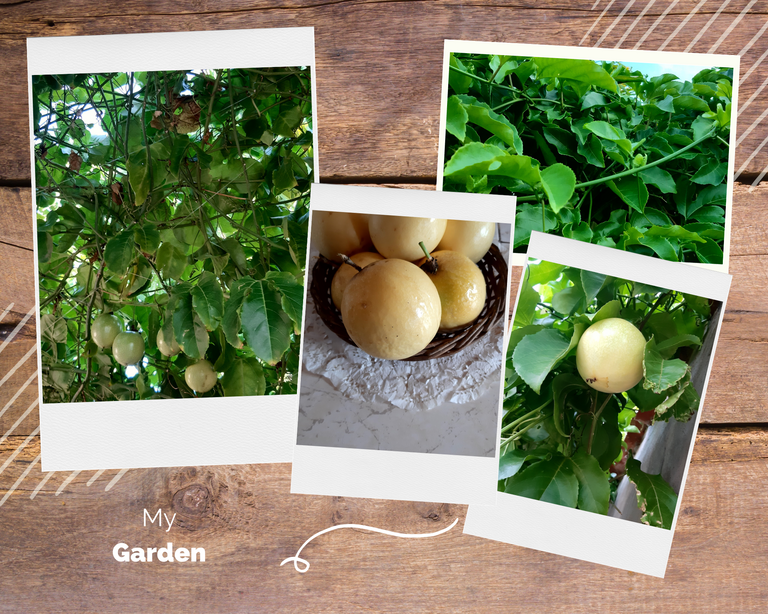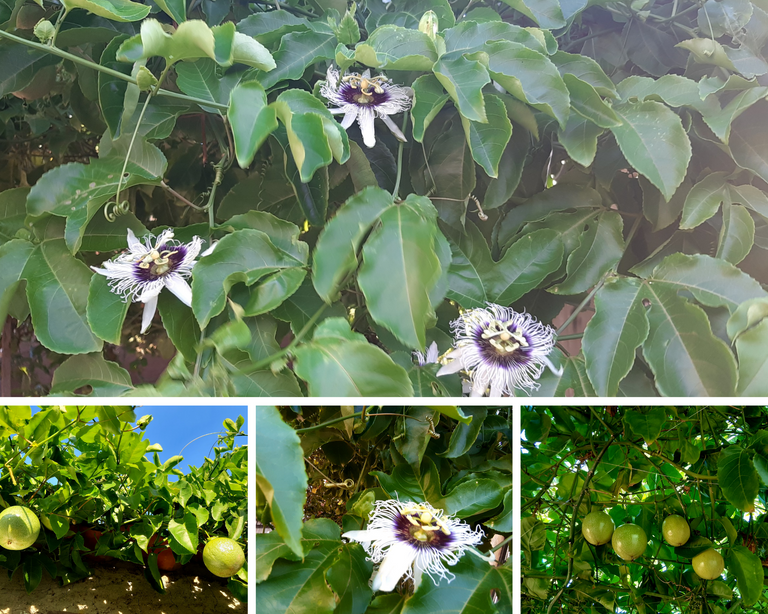Hello everyone, welcome back. For the first time I am going to publish in this community. I hope you enjoy it and like my post.
How the passion fruit became my muse.

Image edit by me using CANVA
It hasn't happened to you, that you've been looking for inspiration to write a post for days, and you can't think of anything. Your mind is blank. Totally absorbed in the many occupations you have to do during the day. So you decide to stop thinking about your next post.
You feel a little frustrated until suddenly, and without thinking about it, you are walking or doing some activity, and Bam! The muse knocks at the door...
Well, that happened to me recently; I resigned for days. I would let the lapse I had set myself to publish my post pass. One afternoon I found myself a cup of coffee in hand in the garden of my house. I spread my eyes on the vine plant and heard the muse whisper: passion fruit.
Immediately and without thinking, I drank the last sip of coffee. I went in search of my cell phone to take the respective pictures. With each shot of the camera, the ideas of how to put together the post began to emerge.
Considerable times my muse is capricious and just as untimely as she comes, she also leaves. After taking the photos, I hurried up to the computer. I turned it on and started typing what you are reading now.
Passionflower (Passiflora edulis), or Passion Fruit, is a climbing plant. Its fruit gives off a pleasant aroma taste and acid to the palate. But when sugar is added, the mixture becomes delicious. That's why I like it so much. It is not for nothing that I decided to plant it in my garden.
My favorite legend about this plant.
This plant is known all over the world by different names.
In my country, Venezuela, it is called parchita; in Brazil, where it comes from, it is known as passion fruit. In Europe, it is called the passion fruit; in the United States, it is called the yellow passion fruit.
One of the stories about this plant that I have always found interesting is where the name "passion fruit" comes from.
Legend tells us that the Spanish colonizers. During their exploration trips through America, they came across this plant; they were astonished by the symbolism of this plant and the crucifixion of Jesus Christ.
They claimed that the symbolisms were:
- The pistils at the flower were the three nails with which Jesus Christ had been crucified (palm of the hands and feet).
- The filaments at the flower represented the crown of thorns placed over the head of Jesus Christ in a mocking tone.
- The five sepals and petals represented the ten apostles present during the crucifixion.
- The symbolism of color. The filaments at the flower are purple, which is related to Easter time. Since catholic believers use this color in their clothing. Doing penance for the favors received.

Image edit by me using CANVA
These expeditionists must have had some reason when this plant is known as passion fruit all over the planet.
Well, friends and readers, I hope you enjoyed this information. Remember this fantastic legend when you are drinking parchita juice. Maybe it can serve as a muse for you too.

Image edit by me using CANVA
- If you want more information about this plant; here I leave the Link
- The photos were taken by me with my Samsung Galaxy A7

Image edit by me using CANVA
Spanish version
Hola a todos, bienvenidos de nuevo. Esta es la primera vez que publicó en esta comunidad. Espero sea de su agrado. Disfrútenlo.
Cómo la fruta de la pasión se convirtió en mi musa.

Imagen editada por mi usando CANVA
No les ha sucedido que llevan días buscando inspiración para su blog y nada de nada, la mente está en blanco, Totalmente absorta entre las tantas ocupaciones que debes realizar durante el día y deciden dejar de pensar en que publicarán.
Se sienten un poco frustrados y así pasan algunos días, hasta que de repente y sin pensar en ello, van caminando o están realizando alguna actividad y ¡Pum! La musa llama a la puerta…
Pues eso me ha sucedido recientemente; llevaba un par de días resignada a dejar pasar el lapso que me había impuesto para publicar; cuando me encontraba taza de café en mano en el jardín de mi casa y pose mis ojos sobre la planta de maracuyá y escuche a la musa susurrar: fruto de la pasión.
Inmediatamente y sin pensarlo bebí los últimos sorbos de café y fui en busca de mi celular para tomar las respectivas fotos; con cada disparo de la cámara se iban asomando las ideas de cómo armar el post.
Como muchas veces mi musa es caprichosa y así de intempestiva como llega también se va, después de tomar las fotos apresure el paso hacia la computadora, la prendí y comencé a teclear esto que están leyendo ahora.
La pasionaria (Passiflora edulis) o Maracuyá es una planta trepadora, su fruto desprende un aroma agradable al gusto y un sabor ácido para el paladar, pero cuando se le agrega el azúcar la mezcla se vuelve deliciosa; de allí la razón para que me guste tanto; no por nada decidí plantarla en mi jardín.
Mi leyenda favorita sobre este planta.
Este planta es conocida a lo largo del mundo con diversos nombres, en mi país Venezuela se le llama parchita, en Brasil de donde es originario se le conoce como maracuyá, en los países europeos se le llama el fruto de la pasión, en Estados Unidos es llamada yellow passion fruit.
Una de las historias acerca de esta planta que siempre me ha parecido interesante es de donde viene su nombre de “fruto de la pasión”. Cuenta la leyenda que fueron los colonizadores españoles, quienes asentados en América al hacer sus diferentes expediciones, se toparon con esta planta y quedaron asombrados con el parecido de esta y los simbolismos de la crucifixión de Jesucristo.
Estos alegaban que los simbolismos eran:
- Los pistilos presentes en la flor eran los tres clavos con los que habían crucificado a Jesucristo (palma de las manos y pies).
- Los filamentos de la flor representaba la corona de espina colocada sobre la cabeza de Jesucristo en tono de burla.
- Los cinco sépalos y pétalos representaban a los 10 apóstoles que estuvieron presentes durante la crucifixión.
- El simbolismo del color. Los filamentos de la flor son de color purpura relacionándose este con la época de Semana Santa. Ya que los creyentes católicos usan este color en sus vestimentas. Haciendo penitencia por los favores recibidos.

Imagen editada por mi usando CANVA
Algo de razón han debido tener estos expedicionarios, cuando esta planta es conocida bajo fruto de la pasión en todo el planeta.
Bueno, amigos y lectores, espero que hayan disfrutado de esta información. Recuerda esta fantástica leyenda cuando bebas jugo de parchita. Tal vez pueda servir como una musa para ti también.

Imagen editada por mi usando CANVA
- Si quieres más información a cerca de esta planta; acá te dejo el Link
- Las fotos fueron tomadas por mi con mi Samsung Galaxy A7.




